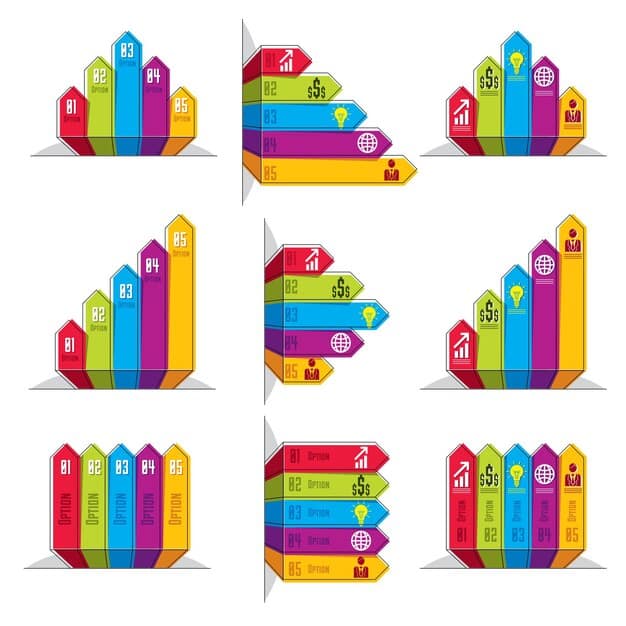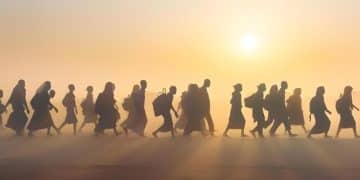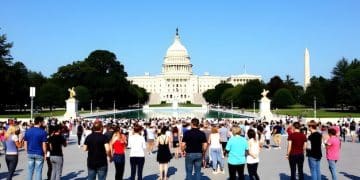New Income Thresholds: How the 15% Increase Affects Your Eligibility

New income thresholds, reflecting a 15% increase in the federal poverty level, significantly impact eligibility for various government assistance programs, potentially enabling more individuals and families to qualify for vital support such as healthcare, food assistance, and housing benefits in 2025.
Are you aware that the recent 15% increase in federal poverty levels could significantly impact your eligibility for crucial government assistance programs? Understanding these new income thresholds is essential for accessing the resources you need.
Understanding the Federal Poverty Level (FPL)
The Federal Poverty Level (FPL) serves as a crucial benchmark for determining eligibility for a wide range of federal and state assistance programs. Annually updated by the Department of Health and Human Services (HHS), the FPL reflects the minimum income needed for a family to meet basic needs.
The FPL isn’t a one-size-fits-all number; it varies based on family size and composition. This ensures that larger families, who naturally have greater expenses, are assessed fairly for eligibility purposes. Let’s delve deeper into how this benchmark impacts access to various essential services.
How the FPL is Calculated
Understanding the calculation of the FPL is essential for grasping its impact. HHS bases the FPL on pre-tax income, considering factors such as inflation and the Consumer Price Index (CPI). This ensures that the FPL reflects the current economic realities and the true cost of living.
- Data Sources: HHS relies on data from the Census Bureau and the Bureau of Labor Statistics to ensure accuracy.
- Annual Updates: Regular updates are crucial to maintaining the FPL’s relevance in a changing economy.
- Regional Variations: While the FPL is a national standard, some states may use modified versions to account for local cost-of-living differences.
The FPL is a critical tool for policymakers and program administrators. By understanding how it’s calculated and applied, we can better assess its effectiveness in supporting vulnerable populations.
The 15% Increase: What Does It Mean?
A 15% increase in the Federal Poverty Level is a significant adjustment that can have far-reaching consequences. This increase directly translates to a higher income threshold for program eligibility, potentially opening doors for many who previously didn’t qualify.
This adjustment aims to reflect the rising costs of living and economic challenges faced by many families. It’s a recognition that the previous FPL may have been insufficient to accurately capture the true needs of those struggling to make ends meet.

Impact on Household Budgets
The 15% increase can provide a much-needed buffer for household budgets, allowing families to allocate resources more effectively. This can be especially beneficial for those facing unexpected expenses or economic hardship.
- Increased Financial Security: Access to assistance programs can reduce the stress of financial insecurity.
- Improved Access to Necessities: Families can better afford essentials like food, healthcare, and housing.
- Greater Economic Stability: Assistance can help families weather economic downturns and maintain stability.
The increase in the FPL offers a vital lifeline for families and individuals facing economic challenges. It can provide the support needed to maintain stability and improve overall well-being.
Key Programs Affected by the New Thresholds
The increase in income thresholds directly impacts eligibility for various federal and state assistance programs. These programs provide crucial support to individuals and families in need.
Understanding how these programs are affected is essential for accessing the resources available. Let’s examine some of the key programs that rely on the FPL for eligibility determination.
Medicaid and CHIP
Medicaid and the Children’s Health Insurance Program (CHIP) provide healthcare coverage to low-income individuals and families. The increased income thresholds can expand access to these programs.
The expanded eligibility can reduce the number of uninsured individuals and improve overall public health. It ensures that more people can access the healthcare services they need.
Supplemental Nutrition Assistance Program (SNAP)
SNAP, formerly known as food stamps, provides food assistance to low-income households. The increased income thresholds can enable more families to afford nutritious food.
- Reduced Food Insecurity: SNAP helps families avoid hunger and malnutrition.
- Economic Stimulus: SNAP benefits stimulate local economies by increasing demand for food products.
- Improved Health Outcomes: Access to nutritious food supports better health and reduces healthcare costs.
SNAP plays a critical role in combating food insecurity and improving the well-being of vulnerable populations. The increased income thresholds can expand its reach and impact.
Housing Assistance Programs
Various housing assistance programs, such as Section 8 vouchers and public housing, help low-income families afford safe and stable housing. The increased income thresholds can alleviate housing cost burdens.
Stable housing is essential for overall well-being and economic stability. Access to housing assistance programs can improve families’ living conditions and reduce homelessness.
Navigating the Eligibility Process
Understanding the eligibility process for these programs is essential for accessing the benefits you need. The application process can vary depending on the program and your location.
Gathering the necessary documentation and understanding the requirements are crucial for a smooth application process. Let’s explore the steps involved in navigating the eligibility process.
Gathering Required Documentation
The first step is to gather the necessary documentation to support your application. This may include proof of income, identity, and residency.
Having all the required documents readily available can expedite the application process and avoid delays. Common documents include tax returns, pay stubs, and identification cards.
Understanding Income Verification
Income verification is a critical part of the eligibility process. Agencies need to verify your income to determine if you meet the income thresholds.
- Pay Stubs: Provide recent pay stubs to document your current income.
- Tax Returns: Submit your most recent tax return for verification of annual income.
- Self-Employment Income: If self-employed, provide documentation of your business income and expenses.
Accurate and complete income verification is essential for a successful application. Be prepared to provide all necessary documentation.
Seeking Assistance from Local Agencies
Navigating the eligibility process can be challenging. Local agencies can provide assistance and guidance.
These agencies can help you understand the requirements, complete the application, and track your progress. They can also connect you with other resources and support services.
Potential Challenges and Considerations
While the increased income thresholds offer significant benefits, there are potential challenges and considerations to be aware of. Understanding these can help you navigate the system more effectively.
One challenge is the potential for increased demand on assistance programs. This can lead to longer waiting times and limited resources. Another consideration is the need for ongoing monitoring and evaluation to ensure the programs are meeting the needs of the community.

Awareness and Outreach Efforts
Effective awareness and outreach efforts are crucial to ensuring that those who are newly eligible are aware of the available resources. This includes providing information in multiple languages and through various channels.
Targeted outreach to underserved communities can help ensure that everyone has equal access to the benefits they deserve. Partnerships with community organizations can enhance these efforts.
Addressing Administrative Hurdles
Administrative hurdles can sometimes hinder access to assistance programs. Simplifying the application process and reducing paperwork can improve efficiency.
- Online Applications: Streamline the application process with user-friendly online platforms.
- Simplified Forms: Reduce the complexity of application forms to make them easier to understand.
- Automated Systems: Use technology to automate verification and eligibility determination processes.
By addressing these administrative hurdles, we can ensure that assistance programs are more accessible and effective.
The Future of Poverty Assistance in the US
The recent increase in income thresholds is just one step in the ongoing effort to combat poverty and improve economic security in the US. The future of poverty assistance will likely involve continued adjustments to income thresholds, as well as innovations in program design and delivery.
There is a growing recognition of the need for a comprehensive approach to poverty reduction that addresses the root causes of economic hardship. This includes investing in education, job training, and affordable housing.
Policy Recommendations for Long-Term Impact
Several policy recommendations can help ensure the long-term impact of poverty assistance programs. These include:
Investing in preventive measures can reduce the need for emergency assistance down the road. Addressing systemic inequalities can create a more level playing field for all.
- Raising the Minimum Wage: A higher minimum wage can lift many families out of poverty.
- Expanding Access to Affordable Childcare: Childcare assistance can enable parents to work and increase their income.
- Investing in Education and Job Training: Education and training programs can equip individuals with the skills they need to succeed in the workforce.
By implementing these policy recommendations, we can create a more equitable and prosperous society for all.
| Key Point | Brief Description |
|---|---|
| 💰 Increased FPL | A 15% rise in the Federal Poverty Level expands eligibility for assistance programs. |
| ⚕️ Healthcare Access | More individuals and families may qualify for Medicaid and CHIP. |
| 🏡 Housing Support | Increased access to programs like Section 8 and public housing. |
| 🍎 Food Assistance | Expanded eligibility for SNAP, helping to reduce food insecurity. |
Frequently Asked Questions
▼
The Federal Poverty Level (FPL) is a measure of income issued annually by the Department of Health and Human Services. It’s used to determine eligibility for certain federal and state programs.
▼
The FPL is typically updated annually. These updates account for inflation and changes in the cost of living to better reflect economic realities for low-income individuals and families.
▼
Many programs use the FPL, including Medicaid, SNAP (Supplemental Nutrition Assistance Program), housing assistance programs, and certain educational programs. The specific eligibility criteria vary by program.
▼
A 15% increase means that the income threshold for eligibility is higher. If your income was previously too high to qualify, you might now be eligible for certain assistance programs.
▼
You can find detailed information on the websites of the specific programs you’re interested in, or by contacting your local social services agency. These resources provide guidance and support.
Conclusion
Understanding the new income thresholds and the impact of the 15% increase in the federal poverty level is crucial for accessing available assistance. By staying informed and navigating the eligibility process effectively, individuals and families can secure the support they need to thrive. Explore the resources mentioned and take proactive steps to determine your eligibility and improve your financial well-being.





